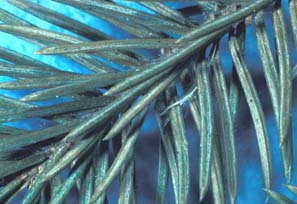Spruce Spidermite | |
|---|---|
| September 30, 2008 | |
|
As fall approaches, the eggs of spruce spidermite and its relatives that have been sitting dormant all summer begin to hatch. Active mites are likely to be found on spruces, pines, junipers, and other needled evergreens in the fall. These mites typically cause more damage in the spring, resulting in tiny, light-colored spots (stippling) that eventually turn brownish. From a distance, foliage appears to be bronze to gray in color. As summer approaches, these mites lay eggs that lie dormant over the summer, and no active mites are found on the trees. This late-spring cessation of feeding typically occurs at about shoot elongation and candle formation, so new growth does not show injury. Mites at this time of year feed on both first-year and previous years’ needles, resulting in the same type of damage as that caused by spring-feeding populations. Scout for the mites by sharply striking branches over a piece of white paper. Many of the mites will be knocked off the branch onto the paper. Slow-moving, greenish to gray mites that streak green when smashed are plant-feeding mites. Faster-moving, reddish mites that streak red when smashed are predatory mites that feed on the spruce spidermites. Based on the relative abundance of spruce spidermites, as well as relative numbers of predatory mites, a control decision can be made. Numerous predatory mites in comparison to plant-feeding mites can probably control the situation without pesticide use. If pesticides are needed, bifenthrin (Talstar), hexythiazox (Hexygon), insecticidal soap, and summer-spray oil should provide control. Summer-spray oil removes the blue bloom from Colorado blue spruces, turning them green. Hexythiazox primarily controls the egg stage, not being very effective against active larvae, nymphs, and adults of mites. Christmas tree growers have the added option of using dimethoate (Cygon). High-pressure water sprays are also effective against mites. These sprays remove all stages, including eggs, from the foliage. Water sprays have the added advantage of being easier on natural enemies than the miticides mentioned. Bifenthrin is a broad-spectrum insecticide and miticide that kills most of the insects and mites on the trees, both harmful and helpful. Hexythiazox kills predatory mite eggs, as well as those of spruce spidermite. Summer-spray oil and insecticidal soap are generally considered to be easy on natural enemies because they are short-lived, compared to the listed miticides. However, this is assuming that adult parasitic wasps, parasitic flies, and various predatory insects fly off of the plant when it is sprayed. Predatory mites, probably the most important natural enemies of spidermites, are unable to fly away, so they and their eggs are likely to be killed. | |
| Author: | Phil Nixon |

